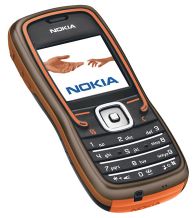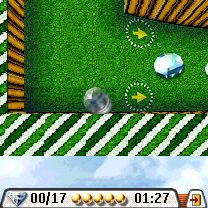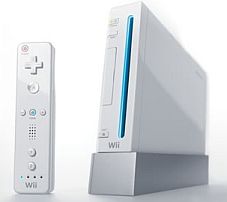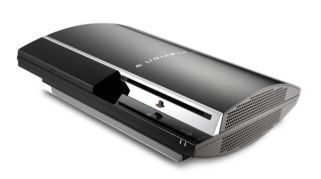Accelerometers (tilt sensors) arrive on mobile phones
 The Nokia 5500 received a fairly quiet launch for a new Symbian model, Nokia didn't even mention that it WAS a Symbian-powered device or smartphone anywhere on its web site or in the official tech specs. What did receive some mention was a unique and useful feature contained in the 5500 called a 3D accelerometer, which detects how the phone moves and is tilted.
The Nokia 5500 received a fairly quiet launch for a new Symbian model, Nokia didn't even mention that it WAS a Symbian-powered device or smartphone anywhere on its web site or in the official tech specs. What did receive some mention was a unique and useful feature contained in the 5500 called a 3D accelerometer, which detects how the phone moves and is tilted.
The 5500 was launched as an exercise phone (its full name is the 5500 Sport) and makes use of the accelerometer primarily as a pedometer or step counter, with special built-in software interpreting the data from the accelerometer to detect how far and fast the phone's owner has run, walked or cycled. As a secondary feature the phone allows the user to control the music player by simply tapping the phone twice from various angles representing various functions (left for last track, right for next track, centre for play or stop).
According to the official developers page for the accelerometer, "Nokia expects to introduce the 3D accelerometer technology to other devices in the future", so they're clearly not planning the 5500 to be a one-off. Perhaps if the accelerometer is cheap and compact enough, and the 5500 is certainly both of those things, it could eventually be included as standard feature, just like vibrating alert technology.
In games
 The memory card that comes with the 5500 includes a S60 3rd Edition game called Groove Labyrinth which uses the accelerometer as a tilt sensor. The sensor allows the player to control the game by simply tilting the phone in the direction of travel, with the angle of tilt controlling the speed of travel (like one of those plastic maze toys where you have to manoeuvre a metal ball through it). It's somewhat similar to the old 1980s classic Marble Madness, and the aim is to tilt the environment so that the ball can travel through a course while avoiding the edges and various other traps. Each level can be cleared by picking up every jewel and reaching the exit before the time runs out. Along the way the player encounters bonuses (extra time, extra lives, shields, teleports) and dangers (collapsing floors and mines). The view of the game is top down, with the 3D landscape visible directly beneath the player.
The memory card that comes with the 5500 includes a S60 3rd Edition game called Groove Labyrinth which uses the accelerometer as a tilt sensor. The sensor allows the player to control the game by simply tilting the phone in the direction of travel, with the angle of tilt controlling the speed of travel (like one of those plastic maze toys where you have to manoeuvre a metal ball through it). It's somewhat similar to the old 1980s classic Marble Madness, and the aim is to tilt the environment so that the ball can travel through a course while avoiding the edges and various other traps. Each level can be cleared by picking up every jewel and reaching the exit before the time runs out. Along the way the player encounters bonuses (extra time, extra lives, shields, teleports) and dangers (collapsing floors and mines). The view of the game is top down, with the 3D landscape visible directly beneath the player. Using the game is odd at first, it's strange that real world actions are replicated in the game, but perhaps the first ever mouse-based games on home computers felt the same way. Once you get used to simply moving the phone and not pressing any buttons it all feels very natural however. Anyone can pick this game up and start playing straight away, there's no need to learn anything.
Using the game is odd at first, it's strange that real world actions are replicated in the game, but perhaps the first ever mouse-based games on home computers felt the same way. Once you get used to simply moving the phone and not pressing any buttons it all feels very natural however. Anyone can pick this game up and start playing straight away, there's no need to learn anything.
The game has single level and tournament modes, and can also be played in a two-player versus mode through Bluetooth.
Groove Labyrinth is by bit-side, the German company which also created the award-winning S60 1st and 2nd Edition game Marble Revolution, which featured a somewhat similar tilting control method on phones that had cameras. Groove Labyrinth is effectively a Marble Revolution built for the accelerometer age.
In applications
Going beyond just games, tilt controls might have some potential uses in serious applications, particularly in simplifying user interfaces on mobile devices where people may want to navigate large amounts of information on a small screen with only one hand free.
One of the most popular features on various devices have been wheels that let people scroll through long lists or pages in an intuitive fashion, spinning the wheel quickly to scroll quickly, spinning it slowly for fine selections. Imagine if the 5500's accelerometer held a similar function, and allowed scrolling to happen even more intuitively by simply tilting the phone. Not just that, but tilt sensing would allow scrolling both up and down (by tilting the phone forward and backward) and side to side (by tilting the phone left and right).
This kind of four-way scrolling would be absolutely perfect for browsing web sites, pages would slide up and down or from side to side, with the direction determined by the direction of the phone's tilt and the scrolling speed determined by its angle of tilt, just like the ball in Groove Labyrinth. Many people have complained about the awkwardness of scrolling using a non-analogue joystick or d-pad, perhaps the accelerometer would be a novel and intuitive cure for this problem. If anyone from Nokia is reading this, please consider implementing this feature on new editions of the S60 OSS browser, it could even be implemented on the 5500 straight away through a downloadable patch or firmware update.
Anyone can develop accelerometer applications for S60 3rd Edition devices that contain the feature, and interested developers should visit the Accelerometer Sensor page at Forum Nokia. One visitor to All About Symbian's message boards pondered using the sensor to create a g-force meter for their car, and Tommi on the official S60 blog suggested turning the 5500 into a lightsabre (I'm not sure if that counts as a serious application though!).

Tilt sensors to dominate gaming?
Tilt sensors on portable games are nothing new, there have been Game Boy Color and Game Boy Advance games that had tilt sensors built into their cartridges (Kirby's Tilt & Tumble and Warioware's Twisted), but only a tiny number of such games appeared due to the extra expense of making the non-standard cartridges as the tilt sensor wasn't built into the GBC or GBA consoles themselves.
Tilt sensors on home console games are also nothing new, but just like portable games they've been held back because they've only been available as special add-on accessories that the vast majority of gamers will never buy. If most potential customers don't have the relevant add-on, very few publishers will support it in their software. The only way to break this cycle of non-support is to include tilt sensors as standard on the hardware, and that is exactly what Nintendo and Sony intend to do now, at least on their home consoles. Launching worldwide over the next few months, the Nintendo Wii and Sony PlayStation 3 will join the Microsoft Xbox 360 as the next generation of home games consoles. While the 360 has a completely conventional joypad, the PS3 and Wii will both feature tilt sensors as standard in their controllers, and the Wii controller will also have a 3D position sensor. These are significant developments, not because the sensors offer anything technologically new (they aren't new) but because the tilt technology is included as standard for the first time, so developers can afford to use them in games intended for a wide audience.
Launching worldwide over the next few months, the Nintendo Wii and Sony PlayStation 3 will join the Microsoft Xbox 360 as the next generation of home games consoles. While the 360 has a completely conventional joypad, the PS3 and Wii will both feature tilt sensors as standard in their controllers, and the Wii controller will also have a 3D position sensor. These are significant developments, not because the sensors offer anything technologically new (they aren't new) but because the tilt technology is included as standard for the first time, so developers can afford to use them in games intended for a wide audience. The PS3's tilt sensor appears to have been a last-minute addition after the expected rumble feature was removed due to legal difficulties with the patent holders, and few games will support tilt on the PS3 (at least to begin with). The Wii's tilt and position sensors have been in the controller from the beginning however, in fact the entire Wii console has been built around the concept of controlling games just by waving your hand. Nintendo aims to attract new gamers to the console world by making the whole process of controlling a game less intimidating and complicated, they even made their controller resemble a television remote control rather than the usual joypad.
The PS3's tilt sensor appears to have been a last-minute addition after the expected rumble feature was removed due to legal difficulties with the patent holders, and few games will support tilt on the PS3 (at least to begin with). The Wii's tilt and position sensors have been in the controller from the beginning however, in fact the entire Wii console has been built around the concept of controlling games just by waving your hand. Nintendo aims to attract new gamers to the console world by making the whole process of controlling a game less intimidating and complicated, they even made their controller resemble a television remote control rather than the usual joypad.
The relevance of the PS3 and Wii for tilt games on phones is clear: there will soon be a vast amount of money poured into developing games with tilt-based gameplay. The ideas behind the games, and indeed the games themselves, could easily find their way onto smartphones, as long as tilt sensors in smartphones become widespread enough to justify publishing games that support them.
